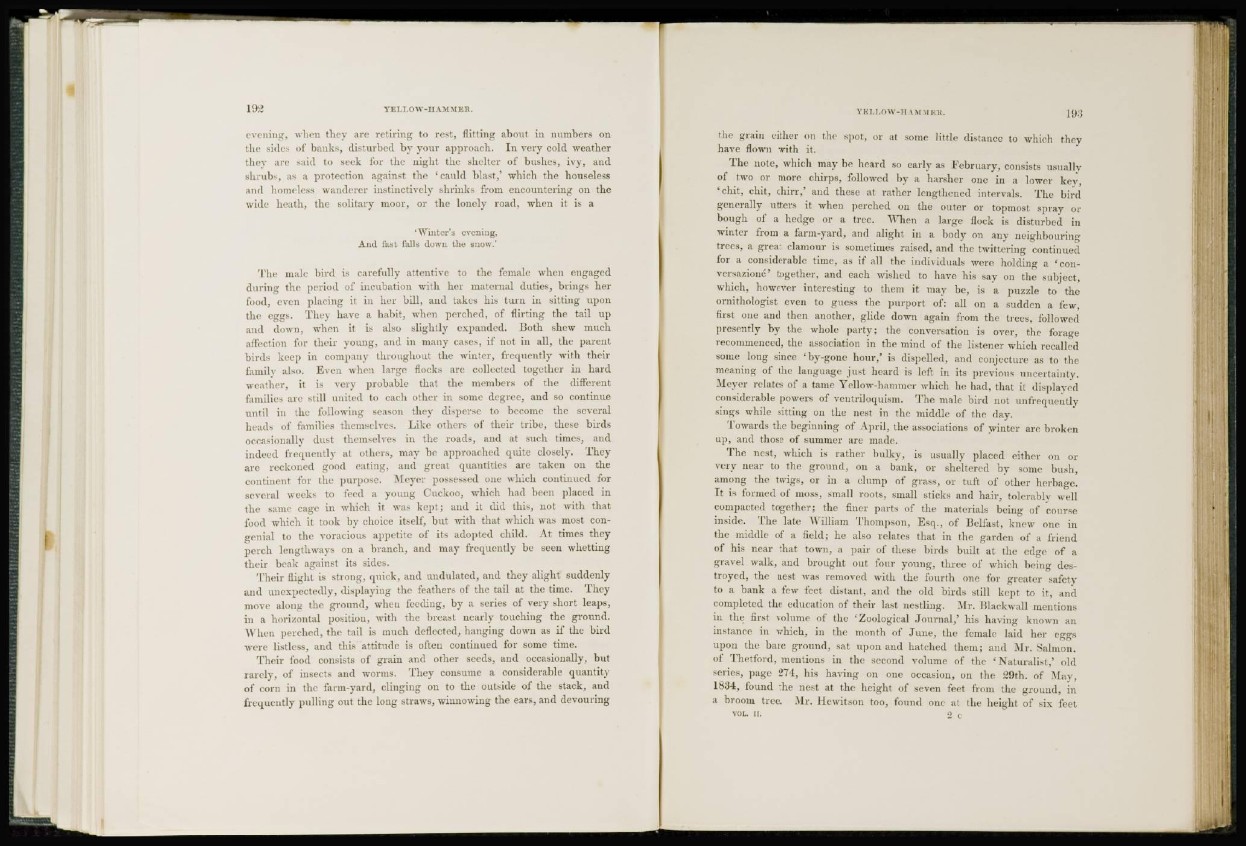
evening, when they are retiring to rest, flitting about in numbers on
the sides of banks, disturbed by your approach. In very cold weather
they are said to seek for the night the shelter of bushes, ivy, and
shrubs, as a protection against the 'cauld blast,' which the houseless
and homeless wanderer instinctively shrinks from encountering on the
wide heath, the solitary moor, or the lonely road, when it is a
'Winter's evening,
And &st falls down the snow.'
The male bird is carefully attentive to the female when engaged
during the period of incubation with her maternal duties, brings her
food, even placing it in her bill, and takes his turn in sitting upon
the eggs. They have a habit, when perched, of flirting the tail up
and down, when it is also slightly expanded. Both shew much
affection for their young, and in many cases, if not in all, the parent
birds keep in company throughout the winter, frequently with their
family also. Even when large flocks arc collected together in hard
weather, it is very probable that the members of the different
families are still united to each other in sonic degree, and so continue
until in the following season they disperse to become the s n eral
heads of families themselves. Like others of their tribe, these birds
occasionally dust themselves in the roads, and at such times, and
indeed frequently at others, may be approached quite closely. They
are reckoned good eating, ami great quantities are taken on the
continent for the purpose. Meyer possessed one which continued for
several weeks to feed a young Cuckoo, which had been placed in
the same cage in which it was kept; and it did this, not with that
food which it took by choice itself, but with that which was most congenial
to the voracious appetite of its adopted child. At times they
perch lengthways on a branch, and may frequently be seen whetting
their beak against its sides.
Their flight is strong, quick, and undulated, and they alight suddenly
and unexpectedly, displaying the feathers of the tail at the time. They
move along the ground, when feeding, by a series of very short leaps,
in a horizontal position, with the breast nearly touching the ground.
When perched, the tail is much deflected, hanging down as if the bird
were listless, and this attitude is often continued for some time.
Their food consists of grain and other seeds, and occasionally, but
rarely, of insects and worms. They consume a considerable quantity
of corn in the farm-yard, clinging on to the outside of the stack, and
frequently pulling out the long straws, winnowing the cars, and devouring
the grain cither on the spot, or at some little distance to which they
have flown with it.
The note, which may he heard so carlv as February, consists usually
of two or more chirps, followed by a harsher one in a lower kev,
'chit, chit, chirr,' and these at rather lengthened intervals. The bird
generally utters it when perched on the outer or topmost spray or
bough of a hedge or a tree. When a large flock is disturbed in
winter from a farm-yard, and alight in a body on any neighbouring
trees, a great clamour is sometimes raised, and the twittering continued
for a considerable time, as if all the individuals were holding a 'conversazione'
together, and each wished to have his say on the subject,
which, however interesting to them it may be, is a puzzle to the
ornithologist even to guess the purport of: all on a sudden a few,
first one and then another, glide down again from the trees, followed
presently by the whole party; the conversation is over, the forage
recommenced, the association in the mind of the listener which recalled
some long since 'by-gone hour,' is dispelled, and conjecture as to the
meaning of the language just heard is left in its previous uncertainty.
Meyer relates of a tame Yellow-hammer which he had, that it displayed
considerable powers of ventriloquism. The male bird not unf'requently
sings while sitting on the nest in the middle of the day.
Towards the beginning of April, the associations of winter are broken
up, and those of summer are made.
The nest, which is rather bulky, is usually placed either on or
very near to the ground, on a bank, or sheltered by some bush,
among the twigs, or in a clump of grass, or tuft of other herbage.
It is formed of moss, small roots, small sticks and hair, tolerably well
compacted together; the finer parts of the materials being of course
inside. The late William Thompson, Esq., of Belfast, knew one in
the middle of a field; he also relates that in the garden of a friend
of his near that town, a pair of these birds built at the edge of a
gravel walk, and brought out four young, three of which being destroyed,
the nest was removed with the fourth one for greater safety
to a bank a few feet distant, and the old birds still kept to it, and
completed the education of their last nestling. Mr. Blackwall mentions
in the first volume of the 'Zoological Journal,' his having known an
instance in which, in the month of June, the female laid her eggs
upon the bare ground, sat upon and hatched them; and Mr. Salmon,
of Thetford, mentions in the second volume of the 'Naturalist,' old
series, page 271, his having on one occasion, on the 29th. of May,
l&M, found the nest at the height of seven feet from the ground, in
a broom tree. Mr. fiewitson too, found one at the height of six feet
VOL. ii. 2 c